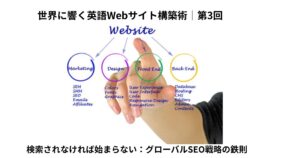Localize Your English Web Writing for International Success (Part 7 – Workflow and Governance)

In this series, we’ve explored the essentials of localizing English web content for international markets. We examined cultural differences, linguistic nuance, SEO writing, UX writing and brand voice. Now, in our final installment, we present a framework for bringing these elements together: a robust workflow and governance model.
A clearly defined workflow ensures consistency, prevents last-minute issues, and reduces costs, while strong governance promotes accountability, efficient decisions, and smooth collaboration between teams. Together, workflow and governance transform good intentions into sustainable practices that deliver culturally relevant content and support international growth.
Key stages of localization
Localization of content can be difficult to manage without a systematic approach. By breaking down the process into distinct stages, teams can use resources more efficiently and maintain higher quality.
Planning and preparation
Begin by identifying target markets, such as the UK and Singapore, and setting measurable goals like boosting conversions or brand awareness. Develop a comprehensive style guide for each region detailing tone, vocabulary, spelling preferences, and cultural dos and don’ts. Include a glossary of key terms to support consistency in localized content.
Content creation
Write source content in clear, neutral English and avoid culture-specific idioms, metaphors and references that may not resonate across markets. This makes content easier to adapt for different markets and reduces effort later. Also, flag any content that will require transcreation.
Translation and transcreation
Rely on professional translators for linguistic accuracy and transcreators to adapt content for cultural resonance and emotional impact. For example, the Japanese concept of "安心" (anshin), conveying a sense of trust and security, might be transcreated as "trusted performance" for Singapore and "one less worry" for the UK.
Quality assurance and review
Have native speakers from each target region review content for linguistic accuracy, cultural appropriateness, and tonal alignment with local expectations. This critical step helps catch awkward phrasing, unintended connotations, and subtle cultural missteps that could undermine user trust.
Publication and testing
Once localized content is approved, publish it and conduct usability testing with members of the target audience. Check that everything feels seamless and intuitive, including form completions, navigation paths, and calls to action (CTAs). Then refine the experience based on user feedback to optimize it for each market.
Tools and technology
Leverage the latest tools and technology to streamline localization across multiple English-speaking markets while maintaining consistency and quality at scale.
Content management systems (CMS)
A flexible CMS makes it easier to adapt your site for multiple regions. Platforms like Drupal and WordPress with WPML allow content to be centrally managed, distributed across languages, and optimized for search engines in different regions.
Translation management systems (TMS)
Deploy a TMS as the hub of your localization efforts across teams and markets. Key benefits include cost savings through the reuse of previously translated segments (translation memory), streamlined workflows, and enhanced consistency through integrated glossaries and style guides. Leading TMS options include Weglot, Smartling, Lokalise and Phrase.
AI and machine translation
Artificial intelligence and neural machine translation (NMT) are powerful tools, especially for generating rapid first drafts of high-volume content. However, human post-editing is essential to ensure translations resonate authentically. This balance of human expertise and AI efficiency can significantly speed your workflow while maintaining high quality. Top NMT engines include DeepL, Google Translate API and Microsoft Translator, while leading AI tools include ChatGPT, Grok and Gemini.
Common challenges
Despite robust workflows and powerful tools, localization teams may still encounter obstacles. Anticipating and planning for them can help you respond more effectively.
Text expansion and contraction
English text is often shorter than content in other languages, such as Japanese, which can cause layout challenges. To accommodate differences in length, use flexible responsive layouts to prevent expensive redesigns.
Tight deadlines and resource limitations
When these challenges arise, prioritize content based on business impact. For example, focus on high-traffic homepages and product pages. Streamline the localization of less critical content by using machine translation with post-editing.
Inconsistent terminology
Multiple translators or markets can lead to inconsistent terminology. Establish clear brand guidelines that define which elements must stay consistent and which can be adapted. Using a TMS can also help ensure consistency and quality as your operations grow.
By recognizing these challenges as common rather than unexpected, organizations can plan practical solutions and avoid last-minute fixes.
Clear governance
Even the best workflows can falter without clear governance defining who makes decisions and how quality is maintained. The approach may vary by project size and market complexity, but successful governance typically shares the following elements:
Defined roles and responsibilities
Assign clear ownership for every aspect of the localization process. This includes defining the responsibilities of localization managers, writers, translators, reviewers, and other team members. Use project management tools like a RACI chart (Responsible, Accountable, Consulted, Informed) to prevent bottlenecks and keep projects on track.
Established feedback loops
Create a streamlined process for local reviewers and regional teams to submit feedback. A two-way feedback loop through a shared form or dedicated communication channel, for example, can help ensure the process is collaborative and continuously improving.
Managed updates
Develop a robust process for updating localized content as products evolve. Governance should specify how updates are tracked, approved, and deployed across markets to prevent localized sites from becoming inconsistent with source updates. This process should be integrated into the overall content calendar, treating localization as an integral part of the global content lifecycle.
Conclusion
Localization is an ongoing investment in brand credibility, customer trust, and international growth. As search trends shift, algorithms evolve, and competitors refine their strategies, a well-structured workflow and governance framework can help you maintain content accuracy, relevance, and engagement across global audiences.











